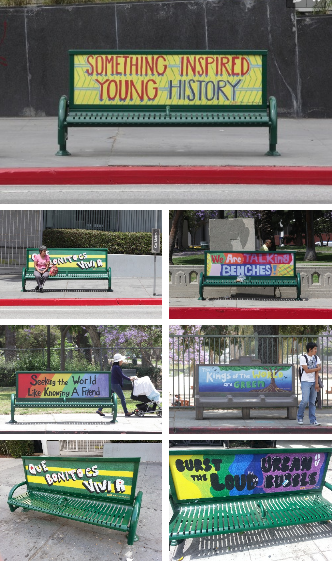A few months ago I noticed some intriguing art appearing on bus benches in my neighborhood between MacArthur Park and Lafayette Park, where Wilshire got its start as a dirt road through a barley field that Gaylord Wilshire named after himself and gave to the city of Los Angeles.*
All the benches carried the logo HOLA Public Art Project. This struck a cord as I remembered a space on the ground level of the Wilshire Royale apartment building (NE corner of Wilshire/Rampart) that in the past had been a venue of restaurants and clubs. More recently unoccupied, the building had suddenly sported the HOLA logo in its window and signs of new life after long being dark. A quick Google search revealed HOLA stands for Heart of Los Angeles, a free after school program in arts, academics and athletics for underserved and at-risk youth begun in 1989. I exchanged e-mails with Lee Schube, Communications Director, and Nara Hernandez, Visual Arts Director, who gave me the skinny on this intriguing project.
The artwork is by HOLA's Visual Arts students, created during “We Are Talking Pyramids,” HOLA’s first public art project. Pearl Hsiung and Anna Sew Hoy, the 2012 Artists in Residence, guided the students as explained in this video and page on the HOLA website.
The 7 benches along Wilshire and 6th Streets will be up for 1 year. Hernandez enthused "It was a great experience to have the youth turn ad space into art space. HOLA has been in the neighborhood for almost 25 years and two years ago we decided that we wanted to give back to the community beyond the constraints of our campus by creating more public art. As a result, we began the HOLA Public Art Project, funded by the Robert Rauschenberg Foundation. It's a series of Public Art Residencies where emerging and established artists collaborate with HOLA youth."
She also kindly shared a description of the design process:
Students at HOLA [used] the cut-up technique, a literary technique in which a text is cut up and rearranged to create a new text. The concept of cut-up can be traced to the Dadaists of the 1920s, but was popularized in the late 1950s and 60s by writer William S. Burroughs, and has since been used in a wide variety of contexts. The cut-up technique was introduced to the students in order to let them discover their own meanings from readily available sources. For this project, the students ... cut-up articles from the Los Angeles Times and local Spanish and Korean language papers to create simple, yet poetic and whimsical phrases. The students [then transferred] their best phrases into a bench design, creating a font for the phrase, as well as designing the motif for the background.
Considering my artistic abilities are limited to drawing stick figures I find the work these students did really rocks. Besides the bench photos accompanying this piece,check out the HOLA public art blog for more examples of the awe-inspiring artistry of the young people HOLA serves. Charles White Elementary School (where Otis/Parsons art school used to be) is right across the street from where I live and during the school year on my way to work I often encounter parents escorting their kids to school.
It is an amazing thought that one of those young scholars I walked past could well be the artist behind the art on the bus bench I sit on while waiting for the bus each weekday. That brings a smile to the face of even a grumpy Uncle like me!
My thanks to Lee Schube and Nara Hernandez for their kind and helpful responses to my query about the benches and supplying photos of several of the benches. And kudos to everyone at HOLA! Check out their website for more about all the great stuff they are doing!
* I learned this from reading Kevin Roderick's excellent Wilshire Boulevard: Grand Concourse of Los Angeles; his recent opionated guide for the Wilshire CicLAvia is a great overview of the Boulevard I consider my community.







